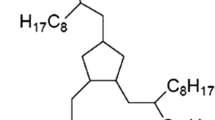Abstract
Under boundary lubrication conditions, the formation of a highly active nascent surface can catalyze the decomposition of lubricant oils. Extreme pressure additives can reduce this decomposition but have undesirable environmental impacts, and so it is necessary to develop eco-friendly lubricants. The following study investigated the effects of the chemical structures of hydrocarbon oils on their tribochemical decomposition by comparing an alkyldiphenylether (ADE) to a multialkylated cyclopentane. The analysis of gaseous decomposition products via mass spectrometry during the application of friction showed that the multialkylated cyclopentane decomposed after an induction period of 1.95 km while the ADE did not degrade, even at a distance of 57.5 km, under the same mechanical contact conditions, and exhibited superior anti-wear properties. However, a high concentration of the ADE was necessary to extend the induction period for lubricant decomposition when it was used as an additive. Although the ADE showed high stability in response to friction, it was prone to decomposition once a nascent steel surface was formed. These decomposition characteristics of the ADE are closely related to its chemical structure, because the ether group in the ADE molecule preferentially adsorbs on metal oxide surfaces, forming a dense and robust film. In contrast, the weak bonding between adjacent alkyl groups reduces the shear strength at the interface. Both the benzene and alkyl groups of ADE molecules were found to detach, followed by the further rupture of C–C, C–H, and C–O bonds, catalyzed by active sites on the nascent surface such as surface defects.












Similar content being viewed by others
References
Mori, S., Suginoya, M., Tamai, Y.: Chemisorption of organic compounds on a clean aluminum surface prepared by cutting under high vacuum. ASLE Trans. 25, 261–266 (1982)
Mori, S.: Adsorption of benzene on the fresh surface formed by cutting under high vacuum. Appl. Surf. Sci. 27, 401–410 (1987)
Mori, S., Yoshida, M.: Decomposition of aromatic compounds on cut nickel surface. STLE Trans. 31, 128–132 (1988)
Mori, S.: Boundary lubrication from the viewpoint of surface chemistry—role of nascent surface on tribochemical reaction of lubricant additives. JTEKT ENGINEERING JOURNAL No. 1008 E (2001)
Shimotomai, N., Nanao, H., Mori, S.: Tribochemical reaction of benzene on nascent steel surface and effect of temperature. Tribol. online 7, 54–59 (2012)
Batchelor, A.W., Cameron, A., Okabe, H.: An apparatus to investigate sulfur reactions on nascent steel surfaces. ASLE Trans. 28, 467–474 (1985)
Pearson, R.G.: Hard and soft acids and bases. Dowden, Huchinson & Ross Inc., Stroudsburg (1973)
Mori, S., Morales, W.: Decomposition of perfluoroalkylpolyethers (PFPE) in ultra-high vacuum under sliding conditions. Tribol. Trans. 33, 225–332 (1990)
Wei, J., Fong, W., Bogy, D.B., Bhatia, C.S.: The decomposition mechanisms of a perfluoropolyether at the head/disk interface of hard disk drives. Tribol. Lett. 5, 203–209 (1998)
Lu, R., Minami, I., Nanao, H., Mori, S.: Investigation of decomposition of hydrocarbon oil on the nascent surface of steel. Tribol. Lett. 27, 25–30 (2007)
Martin, J.M.: Antiwear mechanism of zinc dithiophosphate: a chemical hardness approach. Tribol. Lett. 6, 1–8 (1999)
De Barros, M.I., Bouchet, J., Raoult, I., Le Mogne, Th, Martin, J.M., Kasrai, M., Yamada, Y.: Friction reduction by metal sulfides in boundary lubrication studied by XPS and XANES analyses. Wear 254, 863–870 (2003)
Lu, R., Kobayashi, K., Nanao, H., Mori, S.: Deactivation effect of tricresyl phosphate (TCP) on tribochemical decomposition of hydrocarbon oil on a nascent steel surface. Tribol. Lett. 33, 1–8 (2009)
Lu, R., Mori, S., Kubo, T., Nanao, H.: Effect of sulfur-containing additive on the decomposition of mulyialkylated cyclopeantane oil on the nascent steel surface. Wear 267, 1430–1435 (2009)
Watanabe, J., Mizukami, M., Kurihara, K.: Resonance shear measurement of confined alkylphenyl ether lubricants. Tribol. Lett. 56, 501–508 (2014)
John, P.J., Cutler, J.N., Sanders, J.H.: Tribological behavior of a multialkylated cyclopentane oil under ultrahigh vacuum conditions. Tribol. Lett. 9, 167–173 (2001)
Lu, R., Nanao, H., Koboyashi, K., Kubo, T., Mori, S.: Effect of lubricant additives on tribochemical decomposition of hydrocarbon oil on nascent steel surfaces. J. Jpn. Petrol. Inst. 53, 55–60 (2010)
Author information
Authors and Affiliations
Corresponding author
Rights and permissions
About this article
Cite this article
Lu, R., Nanao, H., Takiwatari, K. et al. The Effect of the Chemical Structures of Synthetic Hydrocarbon Oils on Their Tribochemical Decomposition. Tribol Lett 60, 27 (2015). https://doi.org/10.1007/s11249-015-0606-2
Received:
Accepted:
Published:
DOI: https://doi.org/10.1007/s11249-015-0606-2




